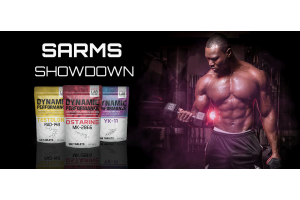SARMS (Selective Androgen Receptor Modulators)

SARMS: The Next Best Thing?
Over the last few years, there has been a surge in the use of SARMS, so called selective androgen receptor modulators to boost performance, accelerate fat loss and, enhance muscle size and strength. Clinically, SARMS could have a lot of potential to offer with regards to muscle wasting and osteoporosis. This is owing to their highly selective nature to androgen receptors in both muscle and bone tissue, while imparting a much weaker influence on those receptors in other tissues such as the prostate (Chen, 2005). This is great, because it means that SARMS could potentially be utilized to enhance muscle mass and bone strength without giving you unwanted side effects such as enlarged prostate, high blood pressure, gynecomastia, fluid retention, cholesterol issues and, heart problems (Rosen and Vilar, 2002). Typically, the androgen hormone testosterone can be used in men to improve body composition, sexual function, decrease body fat, enhance cognitive function and increase muscle mass and strength (Chen, 2005). The problem is, testosterone brings a whole host of problems with it. Since it can be converted in the body to DHT (a more potent form of testosterone) and aromatized to estradiol (a major female sex hormone), testosterone itself is likely to cause an array of side effects. Not only that, application of exogenous (outside) testosterone into the body can significantly suppress your bodies own production of natural testosterone through inhibition of LH (luteinizing hormone), FSH (follicle stimulating hormone) and, GnRH (Gonadotrophin releasing hormone). Not what you want in the long-term! Well, what is promising is that SARMS are neither converted to DHT nor do they exhibit estrogenic-like effects (Chen, 2005). Likewise, SARMS appear to suppress natural testosterone production far less than exogenous androgens (Yin et al, 2003). Considering all this, SARMS do seem to offer a highly attractive and safer alternative to using conventional testosterone!

Jones et al. 2008: Figure shows the increase and subsequent restoration in muscle size (levator Ani muscle) in castrated rats (androgenic deficient) as the dose of SARM (S-4) is increased.
SARMS: There is promise!
In animal studies, SARMS have shown promise in the improvements of bone mass, muscle mass and fat mass. If natural anabolic activity is suppressed, then application of SARMS have been shown to 1) increase the size of anabolic organs (bone and muscle) 2) prevent unwanted hyperplasia (increase in size) of androgenic organs (e.g. prostate) and 3) avoid those high levels of natural testosterone suppression typically seen with exogenous testosterone use (Yin et al, 2003; Jones et al, 2009). Ultimately, SARMS appear to be the next best thing! They provide you with everything you expect (bone and muscle mass elevation) and leave aside all the side-effects (suppression, gynecomastia, high blood pressure, hair loss) you do not want. Seems to be a win-win, right?

Jones et al. 2008: Figure shows the reductions in fat mass and increases in fat-free mass with increasing doses of SARM (S-23).

Yin et al. 2003: Figure shows the increase and restoration of muscle tissue (Leavator Anti Muscle) in castrated rats in response to different doses of SARM (S-1).
SARMS: Increased Benefits, Without the Side Effects
So, it seems like good news for you avid lifters: SARMS have the potential to significantly increase muscle and bone mass, while preventing many side effects such as prostate enlargement, high blood pressure, hair loss, gynecomastia and, natural testosterone suppression. What this means for you is that SARMS could help maximize your nutrition and training program, ultimately helping you to push through those dreaded plateaus and, to accelerate your muscle and fat loss efforts. I guess the answer is obvious: looking for more gains? Then adding in SARMS to your training and nutrition plan could help give you the boost you have always been looking for.
Article written by Stephen Moreton.












